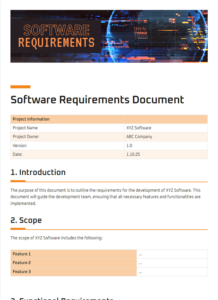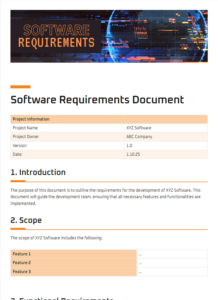A website functional requirements document template is a crucial tool for outlining the specific tasks and functionalities that your website must have. It ensures that your website meets the needs of your users and helps you avoid costly mistakes during the development process. By precisely defining the website functional requirements, you can streamline the development process and create a website that effectively meets your business objectives.
What Should Be Included in a Website Functional Requirements Document Template?
A comprehensive website functional requirements document template should include the following sections:
- Objectives: Clearly state the goals and objectives of your website. What do you want users to be able to do on your site?
- Functional Requirements: List all of the specific tasks that users must be able to perform on your website. For example, you might need users to be able to create an account, purchase products, or access customer support.
- Non-Functional Requirements: These requirements specify how your website should perform. They might include things like speed, reliability, and security.
- User Interface Requirements: Describe the look and feel of your website. This includes things like the layout, colors, and typography.
- Content Requirements: List the types of content that will be on your website. This might include text, images, videos, and downloadable files.
- Testing Requirements: Specify how you will test your website to ensure that it meets the functional requirements.
Benefits of Using a Website Functional Requirements Document Template
There are many benefits to using a website functional requirements document template. By using a template, you can:
- Save time and effort: A template provides a starting point for your document, so you don’t have to start from scratch.
- Ensure completeness: A template helps you ensure that you include all of the necessary information in your document.
- Improve accuracy: A template can help you avoid errors and inconsistencies in your document.
- Enhance communication: A template can help you communicate your requirements more effectively to developers and other stakeholders.
- Reduce the risk of project failure: By clearly defining your requirements, you can reduce the risk of project failure due to misunderstandings or miscommunications.
By investing the time to create a comprehensive website functional requirements document template, you can set your project up for success. A well-written template will help you avoid costly mistakes, streamline the development process, and create a website that meets the needs of your users.


